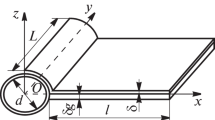Abstract
The coupled boundary-value problem of nonstationary heat and mass transfer within the outer thermal insulation layer and the vapor outlet channel of a combined radiative-evaporative thermal protection system is formulated. The overall dimensional and weight characteristics of the system are calculated for a set of its parameters and two specified modes of the external heat flux and pressure variation, schematically modeling hypersonic aircraft flights 30 min and 60 min long with a maximum heat flux of 105 W/m2. Combined and passive radiative thermal protection systems are compared under the above-mentioned external conditions. It is shown that both the thickness of the outer thermal insulation layer and the total weight of the combined thermal protection system may be considerably less than the passive equivalents.
Similar content being viewed by others
References
L. Roberts, “Radiation and ablation cooling for manned re-entry vehicles,” Advances in Aeronaut Sci., N.Y., Pergamon Press, 4, p. 1019 (1962).
J. H. Bridges and F. D. Richmond, “Design considerations for a re-entry vehicle thermal protection system,” Technol. Lunar Explor., Academic Press, New York (1963), p. 761.
A. P. Kuryachii, “Mathematical model of a thermal protection system with coolant evaporation from a capillary-porous material into a cavity,”Teplofiz. Vys. Temp.,29, p. 540 (1991).
I. N. Bobrov and A. P. Kuryachii, “Numerical modeling of the heat and mass transfer processes in an evaporative thermal protection system,”Inzh.-Fiz. Zh.,62, p. 301 (1992).
V. N. Anan'ev, A. P. Kuryachii et al., “Comparative tests on models of passive and combined thermal protection systems,”Teplofiz. Vys. Temp.,30, p. 1194 (1992).
V. M. Polyaev, V. A. Majorov, L. L. Vasil'ev,Hydrodynamics and heat transfer in porous aircraft structural elements [in Russian], Mashinostroenie, Moscow (1988).
A. P. Kuryachii, “Heat and mass transfer associated with low-velocity vapor flow in the plane channel of a thermal protection system of the radiative-evaporative type,”Izv. Ross. Akad. Nauk, Mekh. Zhidk. Gaza, No.6, p. 22 (1992).
A. P. Kuryachii, “Modeling the unsteady heat and mass transfer in the vapor outlet channel of a radiative-evaporative thermal protection system,”Izv. Akad. Nauk, Mekh. Zhidk. Gaza, No. 1, p. 5 (1994).
J. C. Williams, “Viscous compressible and Incompressible flow in slender channels,” AIAA J., 1, p.186 (1963).
H. Van Ooijen and C. J. Hoogendoorn, “Vapor flow calculations in a flat-plate heat pipe,” AIAA J., 17, p.1251 (1979).
G. N. Abramovich,Applied Gas Dynamics [in Russian], Nauka, Moscow (1973).
A. P. Kuryachii, “The flow in a channel with a wall evaporating under the influence of a radiative-cUonductive heat supply,”Izv. Ross. Akad. Nauk, Mekh. Zhidk. Gaza, No. 5, p. 27 (1993).
V. V. Krasnikov,Conductive Drying [in Russian], Energiya, Moscow (1973)
I. N. Bobrov and A. P. Kuryachii, “Heat and mass transfer characteristics of an evaporative thermal protection system with variation of the external pressure,”Izv. Ross. Akad. Nauk, Mekh. Zhidk. Gaza, No. 1, p. 129 (1993).
S. Bretsznajder,Wlasnosci Gazow I Cieczy [in Polish], Wydawnictwo Naukowo-Techniczne, Warsaw (1962).
Additional information
Moscow. Translated from Izvestiya Rossiiskoi Akademii Nauk, Mekhanika Zhidkosti i Gaza, No. 1, pp. 24–36, January–February, 1995.
Rights and permissions
About this article
Cite this article
Kuryachii, A.P. Efficiency of a radiative-evaporative aircraft thermal protection system. Fluid Dyn 30, 18–27 (1995). https://doi.org/10.1007/BF02029922
Received:
Issue Date:
DOI: https://doi.org/10.1007/BF02029922




